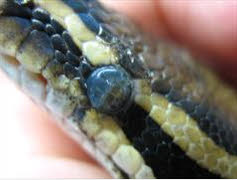Retained spectacle in a ball python

An example of a retained spectacle in a ball python. Photo by Dr. Alyssa Travis
The spectacle, or eyecap, is the scale that covers the eyes in snakes and in some lizard species. The spectacle is formed from fused eyelids that have become clear. When the spectacle does not come off with the rest of the reptile’s shed skin, it is referred to as retained. Retained spectacles make it hard for reptiles to see properly, can cause them not to eat well, and if not removed, then additional layers of spectacles can build up with each subsequent shed.
A snake or lizard with a retained spectacle will have a cloudy, grainy look to the affected eye. This abnormal eye appearance becomes more obvious as additional layers of spectacles accumulate. Snakes and lizards can have one eye affected or both eyecaps may be retained. There may be dried skin visible in the groove between the eye and surrounding scales. Always check your snake’s or lizard’s shed to be sure both spectacles are there.
By far the most common cause for retained spectacles is improper or suboptimal husbandry, especially low humidity, but can also be due to others conditions or diseases. Some of these include external parasites such as mites, infections of the mouth and teeth (mouthrot), and any infections that leads to swelling of the eye.
Affected Species
While any species of reptiles can have eye problems and eye disease, only those species that have spectacles can have a retained eyecap. This includes all species of snakes. All gecko species (like tokay geckos) have spectacles, except those in the eyelid gecko group, such as the leopard geckos and fat-tailed geckos that have eyelids and so can’t have a retained eyecap, and some species of skinks.
Diagnosis
Your veterinarian will start by taking a thorough medical history and give your reptile physical examination. In the vast majority of cases your veterinarian will be able to diagnose a retained spectacle from this examination. Your veterinarian will likely ask detailed questions about your reptile’s husbandry and may suggest some screening tests, likely a blood test, to determine any medical reason for the retained spectacle.
Treatment
A retained spectacle may be treated by placing the reptile in chin deep, cage temperature water (tepid or lukewarm) for 30 minutes to loosen the retained eyecap before it is manually removed. Sometimes a water-soluble gel may be placed on the affected spectacle after the soaking to keep the spectacle soft during removal. Many retained spectacles will come off with gentle but firm rubbing of your veterinarian’s thumb or a moistened cotton swab across the spectacle. For stubborn retained spectacles, a veterinarian may need to use thin-bladed thumb forceps or other tools to lift one edge and loosen it.
In other cases, your veterinarian may suggest placing the snake or lizard inside a damp pillow case containing a moistened towel. It is placed into its cage or other warm environment for several hours. As the reptile crawls, around, it may remove the spectacle. If not, then manual removal as outlined above is needed.
It is important that you take your reptile to a veterinarian for this as attempts at removing retained spectacles by inexperienced people can damage the underlying eye. In addition, your veterinarian may find a reason, other than inadequate husbandry, for the retained spectacle that will need additional treatments beyond just removing the eyecap.
Prevention
Isolation
There is no need to isolate a reptile with shedding difficulties unless a specific infectious disease is detected as a contributing factor.
Quarantine
There is no need to institute quarantine for a reptile with shedding difficulties unless a specific infectious disease is detected as a contributing factor.
Proper Hygiene and Sanitation
Since in the majority of cases, an increase in humidity in all or a part of the cage is needed to resolve shedding and retained spectacle problems, your veterinarian may advise increasing humidity in all or part of the cage. Your veterinarian may suggest one or more ways to provide increased humidity, such as:
- Adding a larger water bowl to the cage
- Increasing the length of misting and/or the frequency of misting in the cage
- Adding a humidifier, a change in the substrate, or the addition of a humidity box. A humidity box may be a plastic container half-filled with damp sphagnum moss or moist paper towels. A hole should be in one side of the box large enough for the reptile to crawl through but not so large that the material inside dries out within a day.
Proper sanitation and hygiene are key risk reducers. As with other infectious diseases, a reptile is better able to resist an infection if given the proper diet and excellent husbandry (i.e., a thermal gradient, appropriate lighting, the right range of humidity, hiding spots). Avoid purchasing reptiles kept under crowded conditions, particularly where there are obvious skin lesions on other specimens sharing the same container.
Prognosis
Good if caught early or if the retained spectacles are removed easily. Guarded if the spectacles are difficult to remove. When retained spectacles are difficult to remove, there may be some damage to the spectacle that will predispose this individual to retained spectacles in the future.